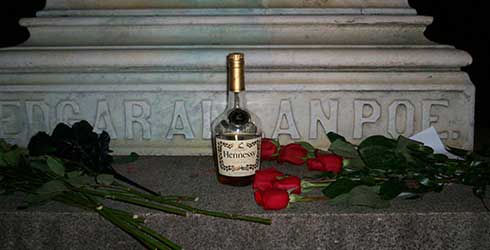


Cada año, el 19 de enero, en la fría noche de Baltimore, un desconocido aparece en la parte vieja del cementerio de Westminster, coloca tres rosas rojas y una botella de coñac en la tumba del inquilino más famoso del cementerio, y desaparece sin decir nada, como vino. La identidad del hombre no ha sido nunca descubierta, a pesar de que la ceremonia lleva ocurriendo durante los últimos sesenta años. Su cara nunca ha sido vista, oculta bajo un sombrero de fieltro negro y una bufanda, y las razones de su gesto son igual de misteriosas.
Las tres rosas rojas son para las tres personas enterradas debajo de la lápida: Edgar Allan Poe, su esposa y prima hermana Virginia Clemm, y la madre de ésta, María. Conocido como el "Brindador por Poe " por los observadores y los entusiastas de Poe, el hombre nunca ha revelado su identidad, ni la razón de su gesto. Poco ha cambiado con los años y cada 19 de enero (cumpleaños de Poe), el hombre aparece, siempre desde una dirección diferente, y siempre a una hora distinta de la noche. Después de servirse una copa de coñac y brindar en dirección a la lápida, coloca las tres rosas rojas y la botella sobre la tumba.
Nadie sabe la razón de la elección de la bebida; el amontillado sería la elección más evidente [El tonel de amontillado (The Cask of Amontillado - 1846) es uno de los cuentos de Poe]. El coñac no jugó un papel prominente en ningún cuento de Poe, ni se sabe que el autor fuera especialmente aficionado a él durante su vida. El ritual sólo dura unos minutos, y el Brindador rápidamente se marcha una vez que ha terminado.
Nadie sabe exactamente cuándo el Brindador por Poe comenzó su homenaje al autor. La aparición más antigua que se conoce está reseñada en un artículo de periódico que data de 1949, en el que un vicario de la Iglesia Westminster menciona que alguien ha estado visitando la tumba de Edgar Allan Poe cada año. Los miembros más antiguos de la congregación dicen recordar haber visto al Brindador desde principios de los años cuarenta, pero no hay ninguna prueba sólida que lo haya demostrado.
La controversia de la ceremonia del recuerdo parece apropiada, ya que la propia muerte de Edgar Allan Poe está envuelta en misterio y polémica. Un escritor aspirante al éxito toda su vida, Poe fue encontrado casi muerto, acurrucado en una calle lateral de Baltimore el día 3 de octubre de 1849. Llevado al Hospital del Condado de Washington, Poe estuvo delirando los cuatro días siguientes. La noche antes de morir, Poe, gritó el nombre de "Reynolds" varias veces, aunque la única persona en la vida de Poe con ese nombre era un conocido lejano.
Durante mucho tiempo se supuso que Poe había muerto de alcoholismo, pero hoy día se discute esta posibilidad. El médico que cuidó de Poe poco antes de su muerte dijo que nunca olió alcohol en Poe, durante el tiempo que éste estuvo en el hospital. En años recientes, se han expuesto varias teorías, proponiendo como posibles causas de la muerte desde la diabetes a la sífilis, la rabia, o el asesinato.
Ninguna tradición de visitar una tumba ha durando tanto tiempo, o ha permanecido tan misteriosa como la del Brindador por Poe, un legado extremadamente apropiado para el autor que conmemora. Sin embargo, este pasado 19 de enero, el misterioso Brindador no ha aparecido provocando preocupación y desatando la especulación de que un destino fatídico se pueda haber abatido sobre el desconocido homenajeador.
Un nuevo misterio se añade al misterio. Le hubiera gustado a Poe.
(But no other grave tradition has lasted as long, or has remained as impenetrable to solution, as the Poe Toaster, a legacy awfully befitting the author that it commemorates. However, last January 19th the mysterious "Poe Toaster" has failed to appear – sparking concern and speculation that some macabre fate has befallen the unknown tribute-payer. A mystery adds up to the mystery. Poe would have liked that.)
Si quieres leer más sobre Edgar Allan Poe:
Poe sites in Baltimore
The Edgar Allan Poe Society of Baltimore
The House of Usher
A Poe Webliography: Edgar Allan Poe on the Internet














No hay comentarios :
Publicar un comentario